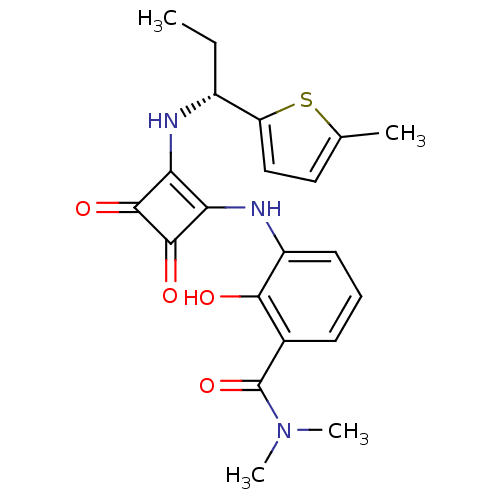BDBM50200877 (R)-2-hydroxy-N,N-dimethyl-3-(2-(1-(5-methylthiophen-2-yl)propylamino)-3,4-dioxocyclobut-1-enylamino)benzamide::CHEMBL415446
SMILES CC[C@@H](Nc1c(Nc2cccc(C(=O)N(C)C)c2O)c(=O)c1=O)c1ccc(C)s1
InChI Key InChIKey=FVNZKJFLVPSOMX-CYBMUJFWSA-N
Activity Spreadsheet -- Enzyme Inhibition Constant Data from BindingDB
 Found 4 hits for monomerid = 50200877
Found 4 hits for monomerid = 50200877
TargetC-X-C chemokine receptor type 2(Homo sapiens (Human))
Schering-Plough Research Institute
Curated by ChEMBL
Schering-Plough Research Institute
Curated by ChEMBL
Affinity DataKi: 5nMAssay Description:Displacement of [125I]IL8 from human CXCR2 expressed in CHO cells by SPAMore data for this Ligand-Target Pair
TargetC-X-C chemokine receptor type 1(Homo sapiens (Human))
Schering-Plough Research Institute
Curated by ChEMBL
Schering-Plough Research Institute
Curated by ChEMBL
Affinity DataKi: 146nMAssay Description:Displacement of [125I]IL8 from human CXCR1 expressed in CHO cells by SPAMore data for this Ligand-Target Pair
TargetC-X-C chemokine receptor type 1(Homo sapiens (Human))
Schering-Plough Research Institute
Curated by ChEMBL
Schering-Plough Research Institute
Curated by ChEMBL
Affinity DataIC50: 235nMAssay Description:Displacement of [125I]hCXCL8 from human CXCR1 receptor expressed in BaF3 cellsMore data for this Ligand-Target Pair
TargetC-X-C chemokine receptor type 2(Homo sapiens (Human))
Schering-Plough Research Institute
Curated by ChEMBL
Schering-Plough Research Institute
Curated by ChEMBL
Affinity DataIC50: 5.30nMAssay Description:Displacement of [125I]hCXCL8 from human CXCR2 receptor expressed in BaF3 cellsMore data for this Ligand-Target Pair
